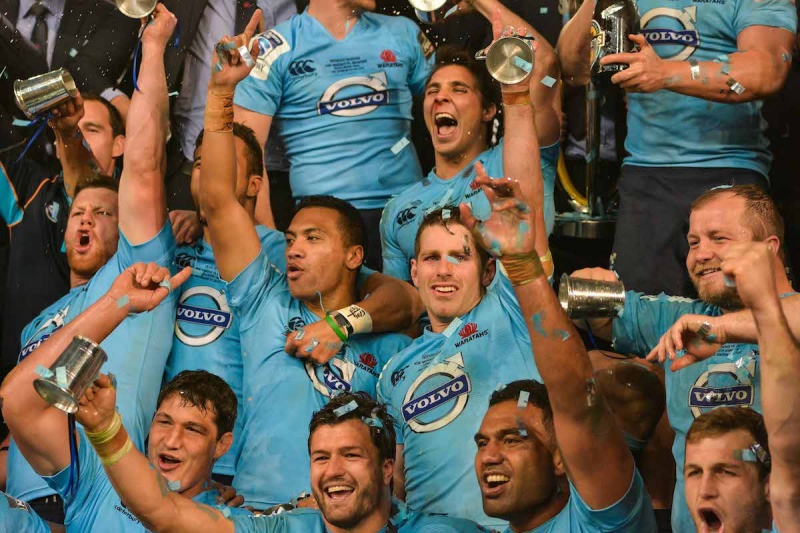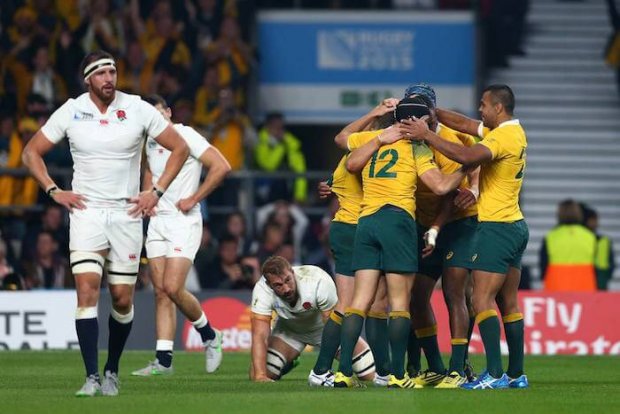So the match didn’t quite go the way we wanted it to. But as we get the body clocks back into a normal rhythm, it’s hard to miss that the future is looking good. This World Cup was the culmination of a variety of trends that all have Australian rugby’s stock pointing upwards. This bandwagon is going places.
The Wallabies
Results at the top have been key. There was simply no rational basis to think, a year ago, that the Wallabies would be in a World Cup final. The entire “program”, to use an Americanism, was in turmoil, from top to bottom.
But a series of smart moves were made that righted the ship, delivering both results and a reinvigorated team ethos. First, Michael Cheika reimposed discipline on a group that was notoriously fractured. Just as importantly, Cheika was able to do it not by excluding some of those responsible, but by co-opting them. There was no scape-goating.
Second, the team rediscovered a clear on-field character. Cheika built upon the attacking mindset of Ewen McKenzie (remember Dublin 2013?), but added to it a new steel in defence and at the scrum that all fans could get behind. The Wallabies have a new, unambiguous on-field identity, something that they haven’t really had since John Eales and Rod Macqueen left in 2001. People are in no doubt as to what the Wallabies represent, both in terms of how they are going to play the game and the values that approach reflects.
Third, Cheika insisted as a condition of his hiring that the ARU reinvest in team staff. One of the most scary things to come out of Patstongate was the many different roles she and just one or two others were performing for the team (all of which she was unqualified for), itself a byproduct of deep cuts to the team management budget. That stopped, and Mario Ledesma started. The rest is history. It’d be great to see Mario hired as a national scrum doctor to work with all franchises and teams moving forward.
Finally, the new regime was able to get the ARU to mitigate its no foreign players stance. This was critical not so much for the individuals involved, but for the bigger picture of rugby in Australia. Market forces and the atomisation of labour are having a huge impact on rugby players, just as for workers in other industries. The ARU desperately needed to get ahead of the issue, after being behind it for so long, and offer players a clear bargain: seven years with us, and you can go get the big pay day in Europe later.
Fortunately, the 2015 Wallabies have backed the ARU up. Both on and off the field they’ve shown fringe and young players that staying in Australian rugby has a lot to offer in the deepest sense. Moreover, essentially for the first time, the flow has actually gone a little the other way, with Dean Mumm and Kane Douglas consciously turning down the Euro route to come back home and go for gold. See also Dane Haylett-Petty and Andrew Smith. The next step will be to develop a system to stop the drain of younger players, like Paul Alo-Emile, who has just started playing over at Stade Francais.
Rugby
But wait, there’s more. The best part about 2015 has been the sentiment that a corner has been turned right across Australian rugby. There have been false dawns, most notably the surge of excitement after the Waratahs’ Super Rugby title in 2014.
 But it seems that we’re back. Rugby matters. See Qantas and Air New Zealand joking about painting each others’ planes. Would that have looked anything but super sad if it was the final of the rugby league World Cup?
But it seems that we’re back. Rugby matters. See Qantas and Air New Zealand joking about painting each others’ planes. Would that have looked anything but super sad if it was the final of the rugby league World Cup?
Back during the Super Rugby season, some opinionated fool on this site (read: me) said that if we couldn’t sort out the lock situation, Australia wasn’t going anywhere at the World Cup. For once, I wasn’t wrong, with a few guys really stepping up to plug that gap. But here’s my favourite part of that picture: Adam Coleman, Blake Enever, Rory Arnold, Luke Jones. These guys not only weren’t even in the five locks that ultimately went to the Cup, they have three caps between them, all Jones’. All are under 24; all have major potential on the test stage.
And that’s just a look at the depth in one position. The investments that the ARU has made in extra Super Rugby sides and now the NRC were long-term ones. I suspect that we will start to reap the value of that harvest in the next few years.
This isn’t a top-heavy rugby revolution, therefore. It’s supported by deliberate changes in the pipeline of player development, designed to support long-term viability for Australian rugby. If there’s one thing New Zealand has shown us, it’s that investment in systems and culture underpins consistent results.
More needs to be done. NRC crowds could be better; talented rugby schoolboys continue to get poached by the mungos; and the sport is yet to fully entrench itself in the social fabric of “mainstream Australia” in the way league and AFL have. But we’re on the right path.
The Grassroots
Which leads us to, err, us. The grassroots.
The site has been flooded with traffic over the last few months, with each week breaking the previous week’s podcast download record. Brian Smith has started writing here, counterbalancing Bob’s pieces. Forcefan has been doing amazing work with the ruck stats; The Dead Ball Area great video analysis; while Matt the gaffer has been on a one-man crusade against looseheads boring in. RugbyReg, as an individual, has been deeply involved in developing the NRC and getting the word out there. The list goes on. And you guys, the grassroots fans, have responded.
Here are some actual headlines from Fairfax’s rugby coverage just this week: “Did David Pocock deliberately stomp on Richie McCaw’s head?”; “Michael Cheika slams ‘disingenuous’ spying”; “All Blacks dance to Bieber song”; “Social media reacts to another All Black triumph”. You don’t even need to read them to process each article: No; Cheika actually couldn’t give a toss; no-one gives a toss; and still no-one gives a toss.
Hopefully, here at GAGR, we fill a widening gap in the media landscape. We take our rugby analysis seriously, but don’t take ourselves too seriously. That the ARU has brought GAGR on board to help shape the NRC moving forward is an acknowledgement of that.
2015 has been a blast. But I think it’s just going to be a new beginning.


